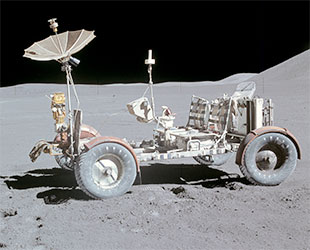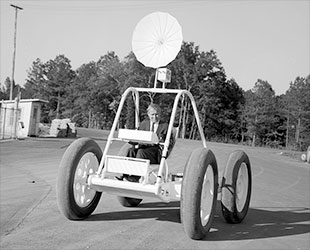October 28, 2015 — A 50-year-old prototype moon buggy has been lost to history after being parked in an Alabama backyard and then being sold as scrap metal, according to documents recently released by NASA.
The space agency had been attempting to recover the test article, a predecessor to the lunar roving vehicle (LRV) the Apollo astronauts drove on the moon, when it was learned that the four-wheeled artifact had been discarded.
The story behind the rover's discovery, and its subsequent disposal, became public through a Freedom of Information Act (FOIA) request by the online magazine Motherboard, which first reported about the relic on Tuesday (Oct. 27).
"It has come to the attention of the Marshall Space Flight Center historian that you may be in the possession of a prototype of a Lunar Roving Vehicle," NASA wrote to the buggy's owner in an August 2014 letter requesting that the LRV be turned over. "Returning the vehicle to the Marshall Space Flight Center would allow MSFC to restore [it] so it might be used for historical and educational purposes."
Unfortunately, the letter arrived too late.
"Upon contacting the current owner," NASA's Office of the Inspector General reported in December, "we learned the LRV had been sold for scrap after [redacted] had passed away."

The Apollo 15 Lunar Roving Vehicle, seen where it is still parked today, was based in part on the Brown mobile test article. (NASA) |
That there was even the chance NASA might have saved the moon rover came as a result of sheer happenstance.
A U.S. Air Force historian had been visiting his mother in Blountsville, Alabama, about an hour south of the Marshall Space Flight Center in Huntsville, when he saw the lunar rover in the backyard of a neighbor across the street. He took pictures of the artifact and sent them to NASA.
The agency, through its chief counsel, then consulted with an engineer who had worked for Brown Engineering on the rover project in the 1960s.
"After providing the current pictures of the rover [to the engineer], he stated he was positive that it was the Mobile Test Article (MTA), later called the Lunar Roving Vehicle, which he designed and delivered to NASA," the agents in the Office of Inspector General (OIG) wrote in a summary of their investigation.
Brown was one of several companies that developed and built prototype rovers before the final design was decided upon and built by Boeing for the Apollo program. Brown's MTA, also referred to as a Local Scientific Survey Module (LSSM), did not closely resemble the final electric car that drove on the moon, but it still played a crucial role towards its development.
"The LSSM prototype represented an important step in the design and engineering of the final rovers utilized during the Apollo program," wrote the chief counsel at MSFC.
NASA didn't release the photos it has of the Brown LSSM to Motherboard, but one of the documents references an image from the Marshall archives of someone driving it on a test track at the center.
The name of the driver is redacted in the FOIA-released papers, but there is a known photo of then-MSFC director and German rocket pioneer Wernher von Braun driving the Brown MTA.

Rocket pioneer and MSFC director Wernher von Braun test drives the Brown Engineering mobile test article in 1965. (NASA) |
The Brown engineer noted that a second MTA had been built, but "it was not of the same construction as the one in question."
It is not clear how the Brown rover came to be parked in a backyard. According to the OIG's investigation, no LSSM or rover was surveyed to be missing, stolen or lost based on available records. But since this LSSM was "no longer available for recovery," the space agency closed its case into the matter.
There are a limited number of prototype, development and production lunar rovers from Apollo still in existence. The three that were driven on the moon remain there today. In addition, an MTA designed by the Bendix Corporation was restored in 2005 by the Cosmosphere in Kansas.
The Smithsonian, which owns the Bendix MTA, also holds in its collection a qualification test unit, vibration test unit and training unit for the Apollo LRV, among other models.
